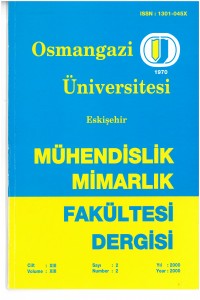Öz
A correlogrcnn approach to the seîection of text-dependent feaîures m
vcweî souncis is invesiigaîed for speaker identificaîion. in the approach, vowel sounds
as the idenîity carrying parts in spoken utterances are represented m the form of a
correlogram, m whıch the speaker dependent spectral and temporaî information is
codsd. Psycho-physiologıcally motivated speclro-temporal correlation with a search
algoriihm is introduced to identify the regions vhere the relevanl features are
embedded thal are suited to discrimination. We identify Ihefeature regionsfor a set of
ındividuaî vowel sounds, and present resulîs on their effectiveness in identifying
speakers. Partıculccr to îhe approach is thaî U makes no explicit use of any individîial
speech features.
Anahtar Kelimeler
Correlogram Vowels Auditory modeling Speaker identtfication..
Kaynakça
- [l] J. P. Campbell, "Speaker recognition: A tutorial", IEEE Proceedings, 85(9), pp 1437-1462. 1997.
- [2] M. R. Sambur, "Selection of acoustic features for speaker identification", IEEE Trans. Acoustics, Speech, and Signal Processing, ASSP-23(2), pp 176-182, 1975.
- [3] C C. Johnson, H. Hollien imd J. W. Hicks, "Speaker identification utilizing selected temporal features", J. Phonetics, 12, pp 19-326, 1984.
- [4] F. K. Soong and A. E. Rosenberg, "On the use of instantaneous and transitional spectral information in speaker recognition", JEEE Trans. Acoustics, Speech, and Signal Processing, ASSP-36(6), pp 871-879, 1988.
- [5] M. Slaney and R. F. Lyon, "On the importance oftime - a temporal representatioıı of sound", in Visual Representations of Speech Signals, by Martin Cooke, Steve Beet and Malcolm Crawford (eds.), Wiley, 1993, pp 279-284.
- [6] J. M. Colombi, T. R. Anderson, S. K. Rogers, D. W. Ruck and G. T. Warhola, Auditory model representation and comparison for speaker recognition", IEEE Proc. Int. Conf On Neural Networks, 1993, pp 1914-1919.
- [7] T. R. Anderson and R. D. Patterson, "Speaker recognition with the auditory image model and self organizing feature maps: A comparison with traditional techniques", ESCA Workshop on Automatic Speaker Recognitİon, Martigny Apdl 5-7, 1994, pp 153-156.
- [8] X. Jiang, 2. Gong, F. Sun and H. Chi, "A speaker recognition system based on auditory model, World Congress on Neural Network, Int. Neural Network Society Annual Meeting, SanDiego, 1994, (4), Ch. 128, D595-D600.
- [9] F. Ertaş, Ses sinyallerine karşı basilar membran hareketinin benzetimi", Elektrik- Elektronik-Bilgisayar Müh. 8. Ulusal Kongresi, Gaziantep, 1999, pp. 618-621,
- [10] R. Meddis, "Simulation of auditory-neural transduction: Further studies", Journ. of Acous. Sac. ofAmenca, JASA 83(3), pp 1056-1063, 1988.
- [11] B. C J Moore, An introduction to the psychology of hearmg", Academic Press, 1989.
- [12] B, S. Atal, Automatic recognition of speakers from their voices", IEEE Proceedings, 64(4), pp 460-475, 1976.
- [13] K. K. Paliwal, "Effectiveness of different vowel sounds in automatic speaker ıdentification", J. Phonetics, 12, pp 17-21, 1984.
Öz
Anahtar Kelimeler
Correlogram Vowels Auditory modeling Speaker identtfication..
Kaynakça
- [l] J. P. Campbell, "Speaker recognition: A tutorial", IEEE Proceedings, 85(9), pp 1437-1462. 1997.
- [2] M. R. Sambur, "Selection of acoustic features for speaker identification", IEEE Trans. Acoustics, Speech, and Signal Processing, ASSP-23(2), pp 176-182, 1975.
- [3] C C. Johnson, H. Hollien imd J. W. Hicks, "Speaker identification utilizing selected temporal features", J. Phonetics, 12, pp 19-326, 1984.
- [4] F. K. Soong and A. E. Rosenberg, "On the use of instantaneous and transitional spectral information in speaker recognition", JEEE Trans. Acoustics, Speech, and Signal Processing, ASSP-36(6), pp 871-879, 1988.
- [5] M. Slaney and R. F. Lyon, "On the importance oftime - a temporal representatioıı of sound", in Visual Representations of Speech Signals, by Martin Cooke, Steve Beet and Malcolm Crawford (eds.), Wiley, 1993, pp 279-284.
- [6] J. M. Colombi, T. R. Anderson, S. K. Rogers, D. W. Ruck and G. T. Warhola, Auditory model representation and comparison for speaker recognition", IEEE Proc. Int. Conf On Neural Networks, 1993, pp 1914-1919.
- [7] T. R. Anderson and R. D. Patterson, "Speaker recognition with the auditory image model and self organizing feature maps: A comparison with traditional techniques", ESCA Workshop on Automatic Speaker Recognitİon, Martigny Apdl 5-7, 1994, pp 153-156.
- [8] X. Jiang, 2. Gong, F. Sun and H. Chi, "A speaker recognition system based on auditory model, World Congress on Neural Network, Int. Neural Network Society Annual Meeting, SanDiego, 1994, (4), Ch. 128, D595-D600.
- [9] F. Ertaş, Ses sinyallerine karşı basilar membran hareketinin benzetimi", Elektrik- Elektronik-Bilgisayar Müh. 8. Ulusal Kongresi, Gaziantep, 1999, pp. 618-621,
- [10] R. Meddis, "Simulation of auditory-neural transduction: Further studies", Journ. of Acous. Sac. ofAmenca, JASA 83(3), pp 1056-1063, 1988.
- [11] B. C J Moore, An introduction to the psychology of hearmg", Academic Press, 1989.
- [12] B, S. Atal, Automatic recognition of speakers from their voices", IEEE Proceedings, 64(4), pp 460-475, 1976.
- [13] K. K. Paliwal, "Effectiveness of different vowel sounds in automatic speaker ıdentification", J. Phonetics, 12, pp 17-21, 1984.
Ayrıntılar
| Konular | Elektrik Mühendisliği |
|---|---|
| Bölüm | Araştırma Makaleleri |
| Yazarlar | |
| Yayımlanma Tarihi | 31 Aralık 2000 |
| Yayımlandığı Sayı | Yıl 2000 Cilt: 13 Sayı: 2 |


